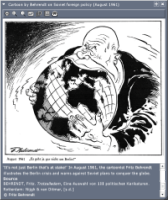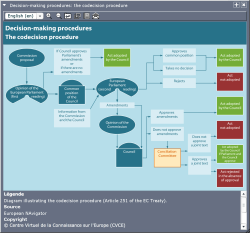
Cartoon of Behrendt
ENA’s structure is divided into two sections: the first documents the
historical events, the other the Community institutions.
The first section features the key dates (1951, 1957,
1973, 1981, 1986, 1995, 2004 …) that have marked the path of
European integration, the enlargements (the
referendums …), the countries, towns
and capital cities (Berlin, Rome, Brussels, Luxembourg, Strasbourg, Frankfurt,
Amsterdam …), the driving forces (the Founding Fathers of Europe, Schuman,
Monnet, Adenauer, Spaak, Thorn …), the summits, the successes and failures
and the important European and international events that have shaped this period
(Schuman Declaration, Schuman Plan, Cold War, Marshall Plan, Suez Crisis, Korean
War …).

The codecision procedure
The other section features the Community institutions and
is organised according to a general structure whereby each institution is presented
in terms of its composition, organisation and operation, powers and
seat. The institutions featured are as follows: the European Commission, the Court of Justice of the European Communities (CJEC), the Court of Auditors, the Economic and Social Council (ESC), the Committee of the Regions, the European Investment Bank (EIB) and the European Central Bank (ECB). The judgments of the CJEC, the operation of the Court of First Instance of the European Communities, the European System of Central Banks (ESCB), the list of Presidents of the Commission and the key stages of the European Monetary System (EMS), of the Economic and Monetary Union (EMU) and of the implementation of the euro and agricultural issues (the common agricultural policy - CAP)
are presented by a wide range of material giving an account of how these institutions have developed.
Discover ENA
< previous



